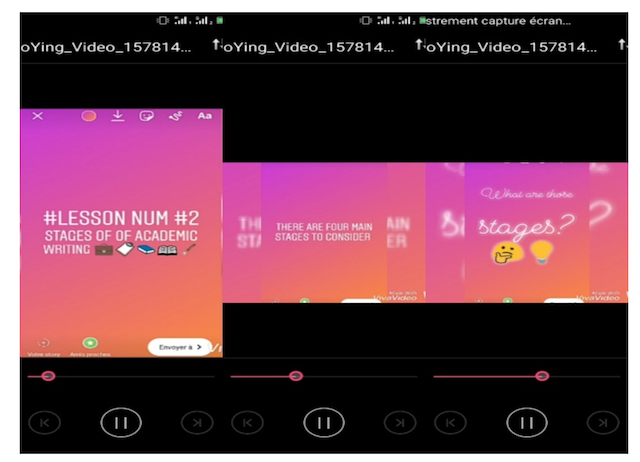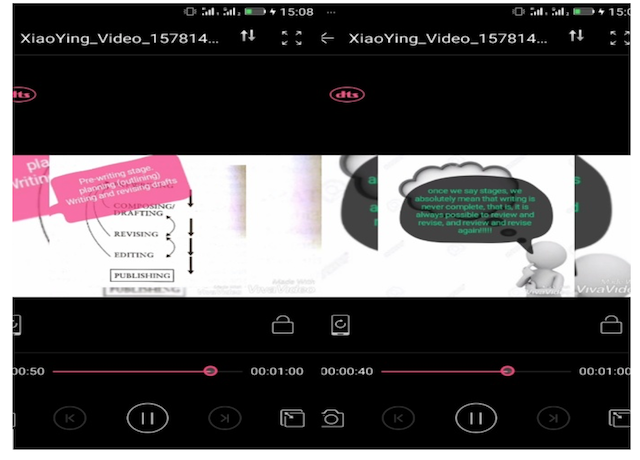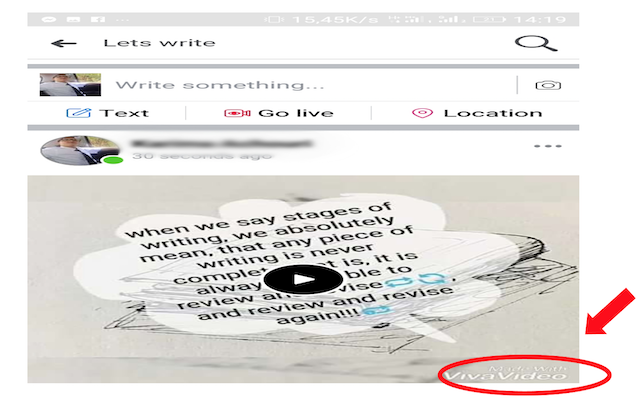Introduction
It is widely recognized that learning a foreign language requires dealing with the four skills; listening, speaking, reading, and writing. Writing, in particular, is viewed by many advocates as the most challenging and problematic skill especially in a foreign context and almost for all students (Heaton, 1975; Hyland, 2003; Graham, Harris & Mason, 2005). Hence, teachers have to respond urgently to the situation and highlight the most important factor in teaching writing, which is practice. During the practice of such a skill, students need to put down on papers what they have in mind; in terms of general background and information, in addition to what they have acquired to come up with an acceptable piece of writing, so through practice students would experience the different steps of the writing process. Referring to the fact that the current generation of students are highly attracted by the use of technology; teachers therefore, might introduce some technology in their classrooms; like the use of the Social Networking Sites (SNSs) such as Facebook, Twitter, LinkedIn and so forth. In this regard, Revere and Kovach (2011, p. 123) stated that :
The rapid rise of online learning and related technologies presents a tremendous opportunity for educators to design courses that engage students through the use of technology. When used appropriately, technology can foster student engagement in the learning process, which any students find beneficial and research has shown to decrease attrition, enhance learning outcomes, and improve student satisfaction.
Since we are living in the 21st century that is characterized by the rapid technological development many difficulties concerning the writing aspects could be lessened to some extent. Lately, new strategies like; “the flipped classroom strategy” has appeared in the educational realm so as to facilitate the process of teaching and learning (Toto & Nguyen, 2009). Therefore, in the present study, the researchers attempted to answer the following questions:
-
To what extent can the introduction of the FC succeed in an EFL context?
-
How would EFL students react to such a new experience?
Accordingly, the following hypotheses have been formulated:
-
Students’ writing performances will statistically increase after the exposure to the intervention (FC).
-
It is assumed that EFL students would be zealous to learn through the use of web-based tools as they usually get attracted by technology.
1. Literature Review
1.1. Writing
Language is everywhere; it expresses our thoughts and ideas as being the primary tool of communication. The way this language is expressed differs, either in an oral mode or in a written mode by the use of the writing skill. Since, writing is “one of the three modes of linguistic expression and communication” (Mastuda & Silva, 2010), it has, therefore, a tremendous importance, as it is used for achieving effective communication in every aspect of life. Academically speaking, the students are in need of this skill to accomplish their scholastic tasks. However, the ability to produce meanings through written texts is not such an easy task as the process needs “the knowledge of how these meanings can be constructed through the use of particular written discourse features” (ibid.). Actually, the degree of complexity of this process would increase in an EFL context rather than “it may seem at first because of the diversity of second language writers with a wide variety of backgrounds, characteristics, needs and goals” (ibid). Similarly, then, EFL teachers’ responsibility would be much harder (Kroll, 1990); therefore, they should provide their students with an opportunity to enhance their skill appropriately, in a way, that could meet their special needs and preferences, and at the same time in a way that could ideally meet some of the educational context hindrances.
1.2. Flipped Classroom
Within the framework of a flipped teaching and learning, the classroom becomes upside down, in that what is used to be presented in the classroom is going to be done at home and vice versa (Lage, Platt, & Treglia, 2000; Bergmann & Sams, 2012B). This model can be referred to as “flipped learning, reversed instruction, blended learning, and inverted classrooms” (Bergmann & Sams, 2012A, Bergmann & Sams, 2012B; Bergmann & Sams, 2013; Chen, Wang, Kinshuk, & Chen 2014). By using such a model teachers could substitute the direct instruction in the classroom with videos that could be viewed either outside class or during it when a student needs a particular content (Bergmann & Sams, 2012B). So, the emphasis is going to be shifted from the teacher to the student and the learning process itself (ibid.). It is worth mentioning that the FC technique is based primarily on two important parts. The first part is the classroom where the students are going to form small groups for interaction and doing assignments. The second part is outside the classroom, this latter requires computer-based individual instruction (Bishop &Verleger, 2013). This concept is better explained in the following graphic representation (Figure 1).
Figure N° 1. A model of flipped classroom
Source: Bishop and Verleger, 2013, p. 6
1.3. Advantages of the Flipped Classroom
Many researchers have highlighted many benefits of the flipped learning as it can promote learning and decrease many challenges that usually appear in the traditional methods (Herreid & Schiller, 2013; Lage, Platt, & Treglia, 2000). In this respect Kim, Kim, Khera and Getman (2014, p. 37) point some benefits of FC, which are listed as follows:
-
Flipped classroom provides students with access to online video lectures prior to in-class sessions so that students are going to be prepared to participate in more interactive and higher-order activities.
-
Students benefit from the outside classroom events because they can allocate their time and pace their online learning to meet their individual levels of comprehension.
-
Teachers become able to commit more in-class time to monitoring student performance and providing adaptive and instant feedback.
On the basis of what has been said, one could notice that time is one challenging aspect in the traditional learning/teaching process; however, with the flipped model such a problem could be solved, as much time would be devoted just for discussion about what has been presented in the video lesson. In a similar way, Güvenç (2018, p. 421) sees that the “…flipped classroom approach not only helps students learn course content out of the class, but also allocates class time for interactive activities”. This could be better explained in the following table:
Table 1. Comparison of class time in traditional versus flipped classroom
|
Traditional Classroom |
Flipped Classroom |
||
|
Activity |
Time |
Activity |
Time |
|
Warm-up activity |
5 min. |
Warm-up activiy 5 min. |
5 min. |
|
Go over previous night’s homework |
20min. |
Q & A time on video |
10 min. |
|
Lecture new content |
30-45 min. |
Guided and independent |
75 min. |
|
Guided and independent |
20-35min. |
||
Source: Bergmann and Sams (2012B, p. 15)
2. Experimental
2.1 Methods and Materials
This research adopted a pre-experimental design. This latter is mainly concerned with studying the effect of the independent variable on just one group; henceforth; the one-group-pretest-posttest (Cohen, Manion, & Morrison, 2018). The purpose behind the choice of this design is to determine whether the intervention gives any effect on the outcome. So, by assigning a test before and after the intervention, the researchers would see whether or not the implementation of the FC has a direct effect on the students’ writing performances. Hence, using one group was just to ensure the success of such a strategy on a small number of students before its larger implementation. The design of the research is shown below:
Figure N° 2. The one-group pre-test post-test design
Source: Cohen, Manion, and Morrison (2018, p. 403)
2.2 Data Collection Tools
This research employed two instruments based on the research problem investigated; they were a pretest and a post test, and a post-interview with a focus group. The use of the focus group was purposefully intended by the researchers to get as much information as they can, as they believed that the students’ interaction would give birth to totally new ideas, as it is raised by Cohen, Manion, and Morrison, 2018 who said that “focus groups are a form of group interview in which reliance is placed on the interaction within the group […] such that the views of the participants can emerge – the participants’ rather than the researcher’s agenda can predominate”. So, the use of those instruments means that we are using a triangulation method of research, which is actually the process “of corroborating evidence from different … types of data (e.g., observational fieldnotes and interviews), or methods of data collection (e.g., documents and interviews) …” (Creswell, 2012, p. 629). As for the writing tests, they involved two descriptive topics which have been corrected and scored on the dependent variable (writing). After that, the researchers compared the two scores of both the pretest and the posttest.
2.3 Participants
The participants of the current study consisted of 35 second year university students (29 female and 06 male) enrolled at Cheikh Larbi, Tebessa University, Algeria. The main reason behind our choice of the target population, i.e., second year students was mainly because of the nature of the study itself, as it required more mature students in terms of using technology, and because of the fact that they are in a critical period wherein they need a careful guidance so as to reach an acceptable level in paragraph writing which is considered to be very basic, as it is widely believed that writing an essay is no more complex than writing a paragraph. As for the sample, it was not chosen by randomization for two main reasons. First, the group was an intact group that was given by the administration. Second, the nature of the study itself belongs to the quasi-experimental design which does not support random assignments.
2.4 Procedures
Prior to the intervention, the researchers asked the students to write a paragraph in order to figure out whether or not the intervention would prove well. After that, the two designed lessons (lesson one: paragraph structure, lesson two: stages of academic writing) were flipped (see Appendix 1 & 2).
Before the discussion moves on, it is important to mention that the intervention was conducted in four weeks. In the first week, the researchers introduced to the students the concept of the FC, and they trained them how to learn through such a strategy. They have also explained to them the objective of using the FC. In the following three weeks, a video lesson was regularly published before the official class time. The concept was quite simple; the researchers published the video lessons in an online platform “Facebook” (see below in Appendix 3) in which the students were supposed to watch the teacher-created videos before they came to the classroom so as to prepare themselves to discuss and practice their “freshly acquired knowledge”. Overall, this study followed four main stages; (1) the preparation of the video lesson, (2) the publication of the video lesson on Facebook, (3) watching this video by the students, and (4) coming to the classroom ready for practice. The lessons were divided into different parts and delivered separately; the length of each video lesson (or part) was approximately between two and three minutes. They were supported mainly by visual aids that were made by the help of a video-editing software application called “viva-video” (see Appendix 4). After conducting the intervention, the students were asked again to write a paragraph (a post-test).
2.5 Data Analysis
During the analysis of the quantitative data, the researchers saw that a paired sample t-test was the suitable method/technique to analyze the significance of both the pre-test and the post-test, as well as, to describe the level of improvement. Since only one group was under investigation, the analysis of the paired sample t-test was carried out by using the Statistical Package for the Social Sciences (SPSS 23.) As for the qualitative data analysis, a conceptual analysis was conducted (coding) to interpret the interviewees’ answers.
3. Findings and Discussion
3.1 Quantitative Data
Table 2. Paired samples statistics
|
Mean |
N |
Std. Deviation |
Std. Error Mean |
||
|
Pair 1 |
pretest |
9.0214 |
35 |
3.23377 |
54661 |
|
posttest |
12.71 |
35 |
3.066 |
.518 |
From the above table (2), we can say that there is an improvement in the students’ writing performances after implementing the FC strategy as the mean score of the post-test is higher than that of the pre-test.
Table 3. Paired samples correlations
|
N |
Correlation |
Sig. |
|
|
Pair 1 pretest & posttest |
35 |
,005 |
,977 |
From the above table (3), we can see that the correlation is (0.005), which means that probabilities 0.00 are interpreted in the correlation between the students’ writing improvements through the use of the flipped strategy. In other words, after the intervention was implemented the students’ scores increased.
Table 4. Paired samples test
|
Paired Differences |
||||||||
|
95% Confidence Interval of the Difference |
||||||||
|
Mean |
Std. Deviation |
Std. Error Mean |
Lower |
Upper |
t |
df |
Sig. (2-tailed) |
|
|
Pair 1 pretest – posttest |
-3.69286 |
4.44455 |
.75127 |
-5.21961 |
-2.16610 |
-4,916 |
34 |
,000 |
From table (4), it can be seen that t-value is 4,916 with a degree of freedom of 34 levels which correlates to a small significant value 0.000 which is itself less than (< 0.05); it means that there is a low probability that the Ho (null hypothesis) is true. The Ho indicated that there is no significant difference between the two mean scores; therefore, it is rejected, and hence, the Ha (the alternative hypothesis that was stated earlier and that indicated that there will be a statistical difference after the intervention) is accepted. Thus, the difference between the two mean scores is statistically significant. The researchers; therefore, concluded that the implementation of the FC increased the students’ writing achievements.
3.2. Qualitative Data
3.2.1 Flipped classroom vs. face-to-face classroom
After the intervention, the students realized that there is a clear cutline between the quality of the lessons which are delivered in a synchronous face-to-face mode, and those delivered in a video-based dimension. They see that the latter has enabled them to be directly in touch with the target lesson, as opposed to the traditional classroom in which the teacher is the one who takes in charge the lesson delivery. They have also reported that, in a “non-flipped classroom”, they enter to the classroom with “zero” knowledge concerning the subject; however, in a FC, they had the opportunity to know more about their next lesson without having to be physically present in the classroom. For instance, in case of absenteeism, students could have an opportunity to check on Facebook and see what they have missed.
3.2.2 Flipping the class via Facebook
The idea of flipping the class via Facebook was really appreciated by the students. To them, since they are “addicted users” to such a platform; this enabled them to have a direct access to the video lessons without thinking about both the “here” and the “now”. So, whenever and wherever they log in into their account, they find a “virtual lesson” (as they have reported).
3.2.3. Learning Pace
Within the tenets of the FC, the students found themselves able to learn at their convenient pace; they did not use this term ‘pace’; however, they meant the fact of learning at a speed that is comfortable and compatible with their own abilities. They said that in case they did not understand, they had that option of rewinding or slowing down the video which is absolutely unavailable in a face-to-face classroom. They added that the equivalence of such option in a traditional classroom is the fact of “raising hands” and “asking for repetition”, and here the repetition might not occur as in the first time, because the teachers may use different words and even a different way to respond to what the students have asked, and in some cases the teachers do not respond immediately or “on the spot” (as they have said) to their requests; rather they delay it because of some circumstances which are out of their control.
3.2.4 Autonomy
Most of the interviewees claimed that learning through the FC strategy raised their self-reliance skills. They claimed that they have got an opportunity to learn at their own pace, where they tried to independently decipher meanings, and negotiate them later on collaboratively during classroom discussion and practice.
Reaching this step in research allowed the researchers to answer the two addressed questions and to confirm the formulated hypotheses. We can safely say now that the introduction of FC in an EFL context could prove successful when conducted appropriately, especially that the participants of the present small-scale study showed a positive reaction toward such a new experience. It should be noted that the present small minority of students represents the current generation of students who are considered to be digital natives.
Conclusion
Referring to the research findings and discussion, there was a significant difference in students’ writing scores; therefore, one could deduce that reversing the traditional teaching could be an optimal solution of some writing issues. In other words, delivering knowledge in an enjoyable and innovative way may raise the students’ autonomy, motivation and enthusiasm as this latter (we mean FC) can award the students with an ample opportunity to learn at their own pace and in a more comfortable situation (learning at home or somewhere else), and investing the extra time only for practice. In essence, as a response to the technology call, EFL teachers have to use some technology inside their writing classrooms. Thereby, the following recommendations have been put forward for future researchers, teachers and practitioners:
-
From our own experience, sometimes it was found difficult to confirm whether or not the students have watched the lesson, although the researchers have embedded some questions at the end of the video. In respect to this, they could adopt a “high-tech” oriented approach to determine whether the students have watched the video by simply embedding questions into the video (Bergmann & Sams, 2012A) through special web-tools, EDpuzzle as an example. Therefore, some technology training concerning how to create videos is extremely required.
-
EFL teachers should flip their writing classroom from time to time, i.e., not every lesson needs to be flipped (Bergmann & Sams, 2013).
-
Teachers have to use online platforms that are known, easy to access, and free, for example; they may use Facebook (as being the most popular SNS in Algeria and especially among students) to post their video lessons.
-
Teachers are not obliged to record videos; they could make a PowerPoint presentation, Prezi presentation or any similar presentation software which has to be supported by “visual aids”.
-
In case students do not have internet connection or have a low-speed access, teachers may share the video lessons through the use of a USB stick as it was the case in the present study.
-
In case students do not have computers at home, teachers then can make a transfer to the students’ mobiles by the use of Shareit, Bluetooth, and so forth (again, that was the case of the present study).









